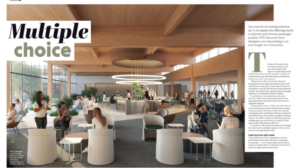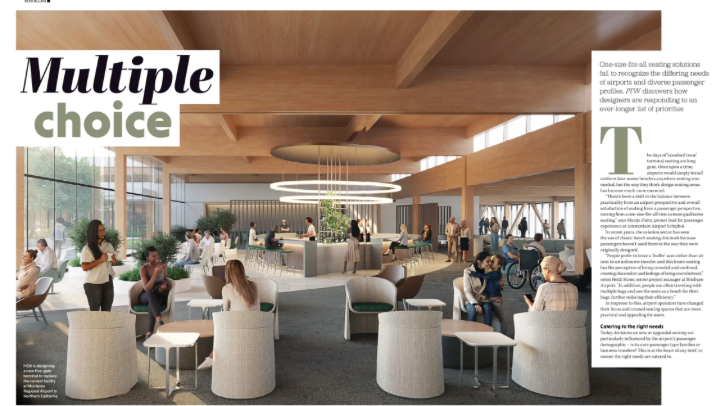One-size-fits-all seating solutions fail to recognize the differing needs of airports and diverse passenger profiles. PTW discovers how designers are responding to an ever-longer list of priorities.
The days of ‘standard issue’ terminal seating are long gone. Once upon a time, airports would simply install uniform four-seater benches anywhere seating was needed, but the way they think design seating areas has become much more nuanced.
“There’s been a shift in the balance between practicality from an airport perspective and overall satisfaction of seating from a passenger perspective, moving from a one-size-fits-all view to more qualitative seating,” says Marijn Duits, project lead for passenger experience at Amsterdam Airport Schiphol.
In recent years, the aviation sector has seen the use of classic bench seating diminish because passengers haven’t used them in the way they were originally designed.
“People prefer to leave a ‘buffer’ seat rather than sit next to an unknown traveler, and this beam seating has the perception of being crowded and confined, creating discomfort and feelings of being overwhelmed,” notes Heidi Stone, senior project manager at Brisbane Airport. “In addition, people are often traveling with multiple bags and use the seats as a bench for their bags, further reducing their efficiency.”
In response to this, airport operators have changed their focus and created seating spaces that are more practical and appealing for users.
Catering to the right needs
Today, decisions on new or upgraded seating are particularly influenced by the airport’s passenger demographic – is its core passenger type families or business travelers? This is at the heart of any brief, to ensure the right needs are catered to.

“Often a denser seating plan reduces circulation space and lowers overall passenger experience.”
Ginger Gee DiFurio, Corgan
“Two main considerations for terminal seating are seat counts and types,” says Ginger Gee DiFurio, VP and studio design director at architecture and design firm Corgan. “The first is based on the volume of passengers during peak hours, and the latter is dependent on the makeup of passenger types and the experiences they’re seeking.”
Airports and airlines have to determine their priorities and the level of service they want to provide, DiFurio explains. For example, they must decide whether they wish to meet or exceed a seat count or provide an exceptional passenger experience.

“Often a denser seating plan reduces circulation space and lowers overall passenger experience,” she says. “Finding a balance between the two is key.”
“It’s almost always a bad plan to try to maximize the number of seats per square meter,” adds Jeremy Corfield, a partner at Concession Planning International (CPI) Australia. “It’s far more important to understand who your guests are and how they travel, and then match the overall seating solution to align with their specific journeys.”
Furthermore, when it comes to deciding how seats should look and feel, and what their features and durability should be, airport design guidelines, national regulations and even airline branding often also come into play.
What passengers want
Seating has to meet changing passenger needs, so many airports regularly survey travelers to learn what they’d like to see. At Seattle-Tacoma International Airport, the most common wishes are for more seating and the ability to charge devices from the seats.
“We’ve been responding to this over the last couple of years concourse by concourse, putting in additional seats, adding more ADA-compliant (Americans with Disabilities Act Standards for Accessible Design) seating and upgrading seats with USB charging points,” says Sabin Mudaliar, senior manager of terminal operations at Port of Seattle.

“Business travelers may prefer touchdown desks for working, while families appreciate children-focused furniture,” he says.

Operators are therefore looking at a wider variety of seating types, from lifestyle-focused chairs to work benches with integrated power. “We’re also seeing new seating models that offer wireless charging rather than USB ports,” adds Mark Wolfe, principal and head of aviation AUS/NZ at architecture and design practice Populous.
“Seating manufacturers are responding to the way people want to travel. They want to be able to work, charge their phones, plug in their laptops. In the case of wanting somewhere to put their hand baggage, they’re responding by integrating little shelves, hooks or platforms into their designs, which will stop passengers taking up other seats with their bags.”
The right seat for the right space
Different zones within an airport have distinct needs depending on their role. Location and function dictate not only the type of seating but also the need for additional design features, such as the types of materials and finishes and the level of durability required. The location of the airport and local culture can also have an effect.

Needs also differ between long-haul and short-haul passengers, as Hanna Hämäläinen, Finavia’s head of passenger services and development, explains: “In the non-Schengen area of Helsinki Airport, airlines have some specific needs at the gate, such as checking travel documents. The gates are slightly larger because the long-haul flights use larger aircraft, and flight transfer times can be long. This has all been taken into account with the seating area, for example by introducing furniture that is easier to lay back on and rest.”

The ’bottom’ line
Appropriate seating is not only good for the bottoms of travelers but is also positive for the airport operators’ bottom lines: happy travelers are likely to spend more time, and therefore money, in the terminal.
As part of its food court and gate lounge seating update, Brisbane Airport has blurred the lines between the two areas by installing a mixture of cluster seating comprising lounge chairs, armchairs and banqueting seating with tables and chairs.
“This not only creates an overflow area in the gate lounges for the food court but also encourages travelers to linger longer at the food and beverage outlets, knowing they can relax in the gate lounge with seating suitable for groups and individuals,” Stone notes.
Maintenance requirements and durability are two factors that can strongly affect the total cost of ownership of a piece of seating. Therefore, operators are looking for items that can be cleaned easily and remain clean for longer, notes Wolfe, pointing to the move away from fabrics to wipe-clean materials like leather or faux leather.

He adds that the construction of seating is also examined closely, with operators choosing those with easily replaceable components to avoid having to change the entire seating unit.
“Being able to reuse and recycle seating is becoming increasingly important to operators, not just from a purely environmental perspective but also from a capex point of view,” he notes.

Durability is a huge consideration in Seattle-Tacoma’s request for proposal (RFP) process, says Grace Choi, program manager for operations project development at Port of Seattle, alongside a product’s ability to be modified.
“Can you add tables to the seating, armrests, cupholders, power? These play a key role in how we pick our seats. We also require that 20% of any contract comes from a minority- or women-owned business enterprise (M/WBE), and we’ve seen some really unique designs and seating coming through from these partners.”
Across the pond in Amsterdam in the Netherlands, Schiphol’s process uses guidelines and criteria from every expert area including operations, safety asset management and passenger experience (PX).
“Every project needs to take these criteria into account,” says Duits. “We’re involved in the major steps and milestones of these projects as PX leads but we also have PX department leads that are working in the day-to-day business of every department of Schiphol to make sure that we’re always involved.”

“Being able to reuse and recycle seating is becoming increasingly important to operators.”
Mark Wolfe, Populous
Sustainability continues to take more prominence these days. For example, it was a key aspect of recent upgrades at Brisbane, where tabletops were made from a recycled mix of glass and resin. According to Wolfe, it’s bound to become more important at every airport.
“I think there’s going to be much more of a focus on this from seating designers, architects and the airports,” he says. “And not just around the materiality. We’ll be looking closer at how they’re manufactured, how far they’re traveling. If it’s timber, how is it sourced? We may see aluminum replaced with other materials due to questions around its sustainability. The circular economy will be front of minds.
“When we talk about passenger experience there’s the idea of customization. It will be interesting to see if this comes down into seating – maybe there will be a new level of functionality and choice within seating, such as adjustable seats like we have with office or car seats.
“Then there’s also more of a focus on inclusivity in design, and ensuring those with physical disabilities are provided for. Perhaps this may go a step further and start considering other kinds of needs, like sensory conditions. It will be interesting to see how this will influence the design of seats and how they’re incorporated into terminals,” Wolfe concludes.
This article originally appeared in the June 2024 issue of Passenger Terminal World. To view the magazine in full, click here.


